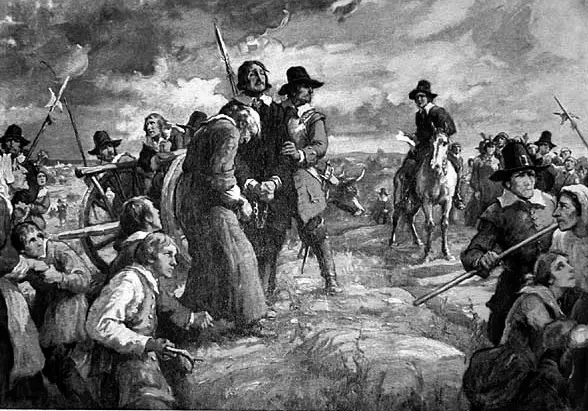Cotton Mather: Voice of Puritanism
Cotton Mather is one of the most famous figures in colonial America. A powerful speaker and leader, he was born into a family of famous ministers. His father, Increase, was minister of the famous South Church in Boston and was also president of Harvard College.
Cotton Mather had a stutter from an early age and despaired of following his father's footsteps. He eventually overcame his impediment, however, and followed through on his family's hopes. He was known as a preacher but moreso as a writer. His works were widely read throughout the colonies, and he published feverishly, eventually having more than 400 of his works in print. He is known for his books  on witchcraft, but he also wrote on medicine, an interest of his before he solved his speech problem. One of his scientific books, Curiosa Americana, won him election to the Royal Society of London.
on witchcraft, but he also wrote on medicine, an interest of his before he solved his speech problem. One of his scientific books, Curiosa Americana, won him election to the Royal Society of London.
He is most known, however, for his involvement in the Salem Witch Trials. In 1684, he published Remarkable Providences, a book about witchcraft in general and the possession of one family's children in particular. The Goodwin family of Boston had a laundress, Goody Glover. One day after an argument with Glover, 13-year-old Martha Goodwin started exhibiting strange behavior. Her three siblings began to act strangely as well. Glover was soon arrested and tried on a charge of witchcraft. Mather became personally involved in this series of events, meeting twice with Glover to try to get her to repent and taking Martha Goodwin into his own house for closer observation. Even though Goody Glover was hanged, Martha continued to behave strangely. Despite this, Mather put down her behavior to witchcraft and wrote about the events in detail in his book.
 Mather initially warned the Salem magistrates to avoid putting stock in spectral evidence. They, of course, ignored his advice. He was present at only one execution, that of former minister George Burroughs. Mather's hatred of Burroughs was so great that he joined the crowd in urging Burrough's death.
Mather initially warned the Salem magistrates to avoid putting stock in spectral evidence. They, of course, ignored his advice. He was present at only one execution, that of former minister George Burroughs. Mather's hatred of Burroughs was so great that he joined the crowd in urging Burrough's death.
Because of his many sermons depicting a life-and-death struggle for people's souls between God and the devil, Mather was popular with the fire-and-brimstone crowd, which was sizable in New England at the time. His book Remarkable Providences also served more or less as a blueprint for the Salem magistrates who sent so many people to the gallows. After the last executions, Mather published another book, The Wonders of the Invisible World, in which he described and, some argue, justify the trials and their results. Many historians assert, however, that this book is full of descriptions that don't quite match facts. Another author, Robert Calef, refuted many of Mather's claims in a later book, More Wonders of the Invisible World, published just eight years after the events in Salem.
In the 18th Century, Mather continued his religious pursuit but turned increasingly to science as well. He performed one of the country's first plant hybridization experiments and encouraged scientists to inoculate against smallpox, which struck Boston with a vengeance in 1721.
Mather died in 1728, of natural causes.



 on witchcraft, but he also wrote on medicine, an interest of his before he solved his speech problem. One of his scientific books, Curiosa Americana, won him election to the Royal Society of London.
on witchcraft, but he also wrote on medicine, an interest of his before he solved his speech problem. One of his scientific books, Curiosa Americana, won him election to the Royal Society of London. Mather initially warned the Salem magistrates to avoid putting stock in spectral evidence. They, of course, ignored his advice. He was present at only one execution, that of former minister George Burroughs. Mather's hatred of Burroughs was so great that he joined the crowd in urging Burrough's death.
Mather initially warned the Salem magistrates to avoid putting stock in spectral evidence. They, of course, ignored his advice. He was present at only one execution, that of former minister George Burroughs. Mather's hatred of Burroughs was so great that he joined the crowd in urging Burrough's death.
